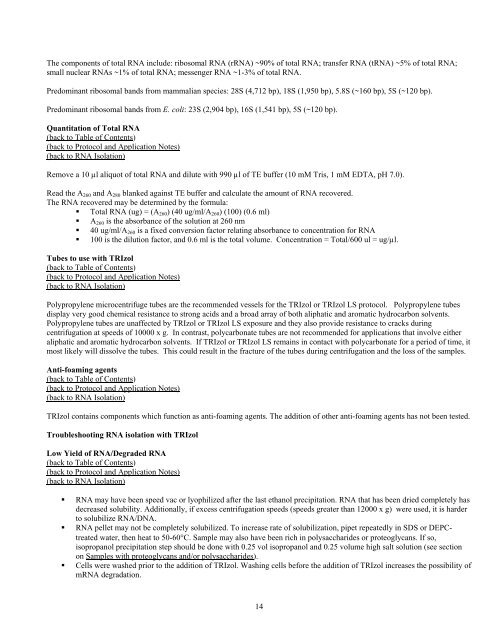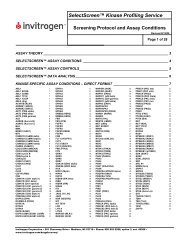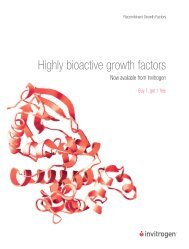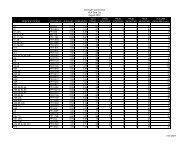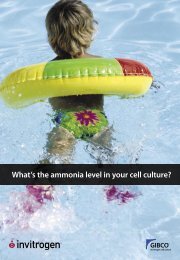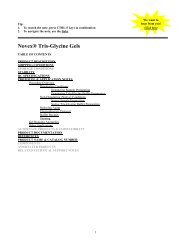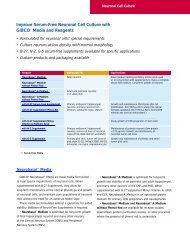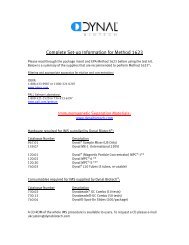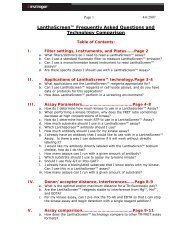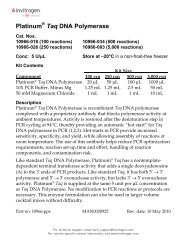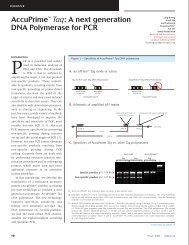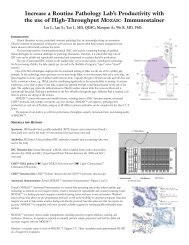TRIzol Reagent - Invitrogen
TRIzol Reagent - Invitrogen
TRIzol Reagent - Invitrogen
Create successful ePaper yourself
Turn your PDF publications into a flip-book with our unique Google optimized e-Paper software.
The components of total RNA include: ribosomal RNA (rRNA) ~90% of total RNA; transfer RNA (tRNA) ~5% of total RNA;<br />
small nuclear RNAs ~1% of total RNA; messenger RNA ~1-3% of total RNA.<br />
Predominant ribosomal bands from mammalian species: 28S (4,712 bp), 18S (1,950 bp), 5.8S (~160 bp), 5S (~120 bp).<br />
Predominant ribosomal bands from E. coli: 23S (2,904 bp), 16S (1,541 bp), 5S (~120 bp).<br />
Quantitation of Total RNA<br />
(back to Table of Contents)<br />
(back to Protocol and Application Notes)<br />
(back to RNA Isolation)<br />
Remove a 10 µl aliquot of total RNA and dilute with 990 µl of TE buffer (10 mM Tris, 1 mM EDTA, pH 7.0).<br />
Read the A260 and A280 blanked against TE buffer and calculate the amount of RNA recovered.<br />
The RNA recovered may be determined by the formula:<br />
Total RNA (ug) = (A260) (40 ug/ml/A260) (100) (0.6 ml)<br />
A260 is the absorbance of the solution at 260 nm<br />
40 ug/ml/A260 is a fixed conversion factor relating absorbance to concentration for RNA<br />
100 is the dilution factor, and 0.6 ml is the total volume. Concentration = Total/600 ul = ug/µl.<br />
Tubes to use with <strong>TRIzol</strong><br />
(back to Table of Contents)<br />
(back to Protocol and Application Notes)<br />
(back to RNA Isolation)<br />
Polypropylene microcentrifuge tubes are the recommended vessels for the <strong>TRIzol</strong> or <strong>TRIzol</strong> LS protocol. Polypropylene tubes<br />
display very good chemical resistance to strong acids and a broad array of both aliphatic and aromatic hydrocarbon solvents.<br />
Polypropylene tubes are unaffected by <strong>TRIzol</strong> or <strong>TRIzol</strong> LS exposure and they also provide resistance to cracks during<br />
centrifugation at speeds of 10000 x g. In contrast, polycarbonate tubes are not recommended for applications that involve either<br />
aliphatic and aromatic hydrocarbon solvents. If <strong>TRIzol</strong> or <strong>TRIzol</strong> LS remains in contact with polycarbonate for a period of time, it<br />
most likely will dissolve the tubes. This could result in the fracture of the tubes during centrifugation and the loss of the samples.<br />
Anti-foaming agents<br />
(back to Table of Contents)<br />
(back to Protocol and Application Notes)<br />
(back to RNA Isolation)<br />
<strong>TRIzol</strong> contains components which function as anti-foaming agents. The addition of other anti-foaming agents has not been tested.<br />
Troubleshooting RNA isolation with <strong>TRIzol</strong><br />
Low Yield of RNA/Degraded RNA<br />
(back to Table of Contents)<br />
(back to Protocol and Application Notes)<br />
(back to RNA Isolation)<br />
RNA may have been speed vac or lyophilized after the last ethanol precipitation. RNA that has been dried completely has<br />
decreased solubility. Additionally, if excess centrifugation speeds (speeds greater than 12000 x g) were used, it is harder<br />
to solubilize RNA/DNA.<br />
RNA pellet may not be completely solubilized. To increase rate of solubilization, pipet repeatedly in SDS or DEPCtreated<br />
water, then heat to 50-60°C. Sample may also have been rich in polysaccharides or proteoglycans. If so,<br />
isopropanol precipitation step should be done with 0.25 vol isopropanol and 0.25 volume high salt solution (see section<br />
on Samples with proteoglycans and/or polysaccharides).<br />
Cells were washed prior to the addition of <strong>TRIzol</strong>. Washing cells before the addition of <strong>TRIzol</strong> increases the possibility of<br />
mRNA degradation.<br />
14


